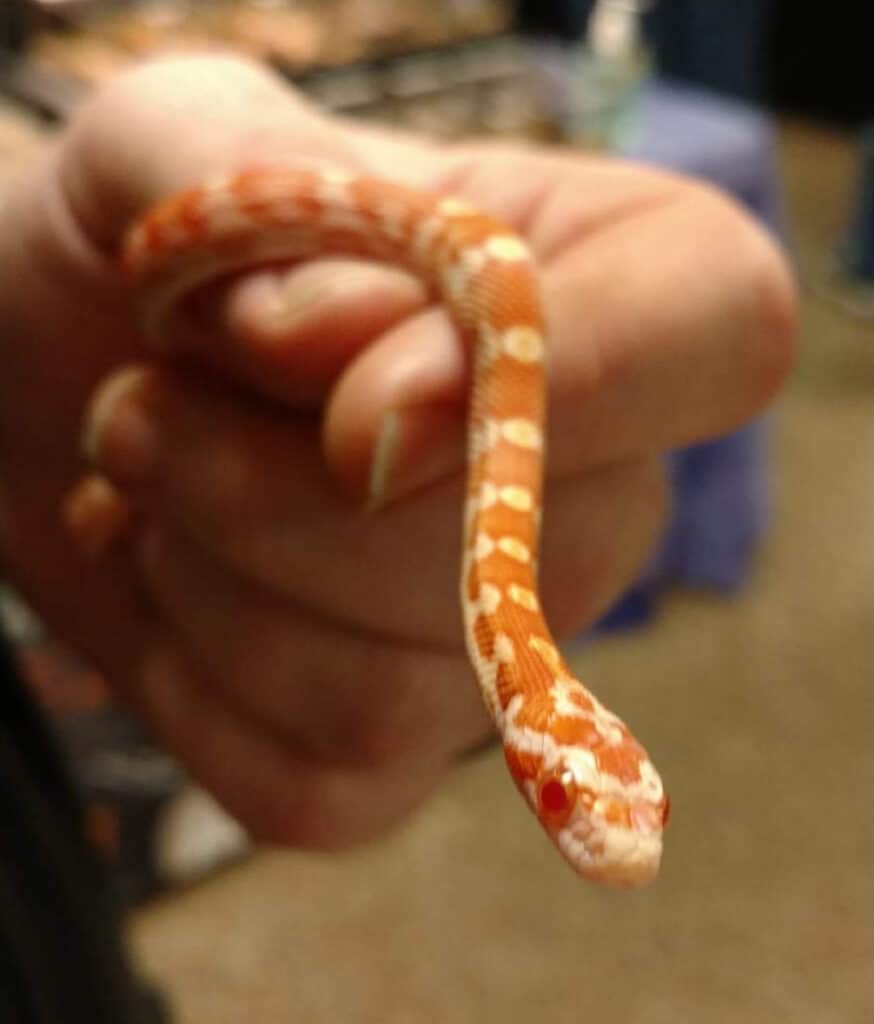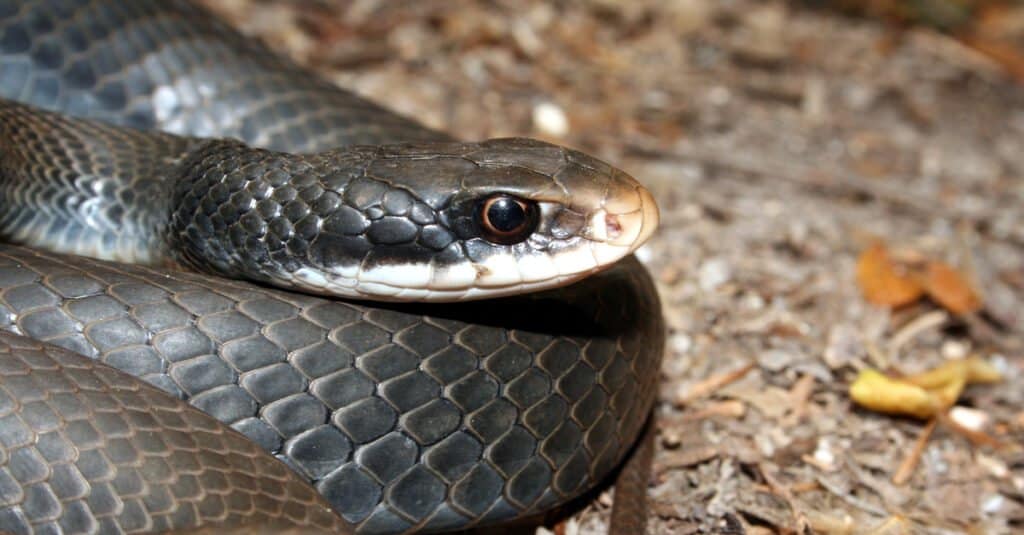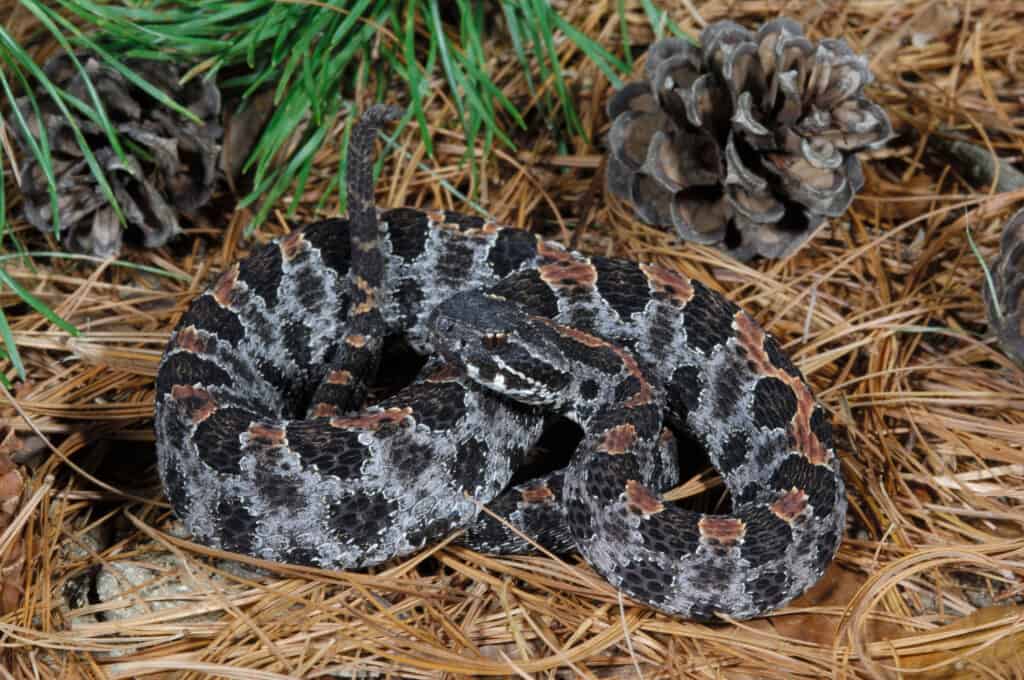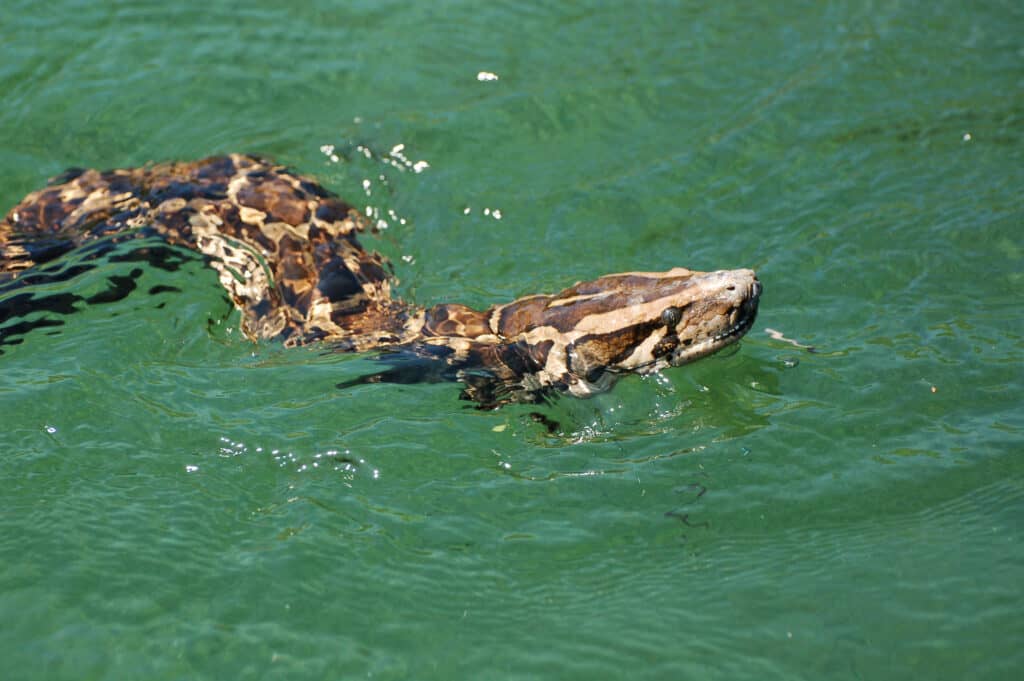Discover Florida’s most snake-infested area with us as we walk you through the Everglades snake species. Are you aware that there are over 50 species of snakes in Florida and 23 of these species live in the Everglades alone?
That is almost half the snake population of Florida in one area, so join us as we walk you through this phenomenon.

Discover the Everglades, Florida’s most snake-infested area, which includes Eastern diamondback rattlesnakes. They are reddish-brown with diamond markings and grow to 7.9 feet, the largest ever was 10 feet long.
©Chase D’animulls/Shutterstock.com
The Everglades – Most Snake-Infested Area In Florida
The Everglades is a large subtropical wetland in southern Florida. It is home to diverse groups of wildlife, including alligators, crocodiles, turtles, and, of course, snakes.
Many types of snakes live in the Everglades, creating a snake infestation in this region. Some snakes that populate the Everglades include the eastern diamondback rattlesnake, cottonmouth, copperhead, coral snake, and water moccasin.
The warm climate and abundance of food make the Everglades an ideal habitat for snakes. As a result, it is considered the most snake-infested area in Florida. So, if you are living near a snake-infested area, it is good to know the details of which are non-venomous and which are deadly.
Non-Venomous Everglades Snakes
Of the 23 snake species in the Everglades, 19 are non-venomous. These snakes play an important role in controlling the populations of rodents and invertebrates. This control helps to keep the balance of nature in check. Unfortunately, some snakes were introduced to the area and have become invasive species, while others are indigenous to the region.
A few of the non-venomous snakes in the Everglades include the corn snake, garter snake, southern black racer, and the scarlet kingsnake. These snakes are non-aggressive and will only bite if threatened. However, between the toxic and harmless snakes, you should still discover Florida’s most snake-infested area and how to recognize these snakes.
Corn Snake (Elaphe Guttata Guttata)

Corn snakes are not poisonous and grow between 4 and 6 feet, with some reaching 8 feet long.
©iStock.com/Desiree Shepherd
The corn snake is a rat snake subspecies native to the southeastern United States. Corn snakes are typically orange or red with black and white stripes.
These snakes are non-venomous and average 4 to 6 feet long, although some may grow up to 8 feet. Corn snakes make popular pets because of their docile nature and ease of care. These snakes eat rodents such as mice or rats, birds, and other small animals.
Eastern Garter Snake (Thamnophis Sirtalis Sirtalis)

Eastern garter snakes are brown or green and have white stripes on their sides. These snakes are not poisonous and only grow between 2 and 4 feet long.
©Erik Agar/Shutterstock.com
The Eastern garter snake is another one that is not venomous. It gets its name from the stripes that run down its body. These snakes can grow between 2 and 4 feet long and are usually brown or green.
The Eastern garter snake is a timid snake often hiding in the grass or under rocks. Eastern garter snakes are active during the day and live close to water sources such as ponds and streams.
Southern Black Racer (Coluber Constrictor Priapus)

Southern Black Racers have dark grey or black coloration with no patterning and can grow to 5 feet.
©Psychotic Nature/Shutterstock.com
The Southern black racer (Coluber Constrictor Priapus) is a subspecies of the common black racer native to the southeastern United States. This non-venomous racer is prevalent in the region, inhabiting various environments such as forests, wetlands, and urban areas.
Their appearance is like the standard black racer, but they tend to be smaller and have a dark grey or black coloration with no patterning. They provide an essential service to the ecosystem by preying on rodents and other small animals.
Scarlet Kingsnake (Lampropeltis Triangulum Elapsoides)

The snout of the scarlet kingsnake is always red, making it an easily identifiable feature when living near a snake-infested area.
©iStock.com/JasonOndreicka
The scarlet kingsnake is a non-venomous snake found in the Everglades with a bright red body and black bands. Although this species is not an aggressive snake, it will bite if provoked. Also, it is a shy snake active during the day but occasionally comes out at night.
This snake feeds on lizards, frogs, snakes, and small mammals, helping control the rodent population. While it is not a protected species, killing or removing a scarlet kingsnake from the Everglades is illegal.
Venomous Serpents Mean Snake-Infested Areas In The Everglades
The Everglades has four venomous snake species: the eastern diamondback rattlesnake, the dusky pigmy rattlesnake, the cottonmouth, and the coral snake.
All these snakes are dangerous and can cause severe injury or death, which is why it is critical to know more about them when living near a snake-infested area like the Everglades.
Eastern Diamondback Rattlesnake (Crotalus Adamanteus)
The Eastern diamondback rattlesnake is venomous and one of the biggest snakes in North America. It features characteristic brown or reddish-brown coloring, dark brown or black bands, and diamond-shaped markings. Adult rattlers usually grow to lengths of 1.8 to 2.4 meters (5.9 to 7.9 ft), but the largest recorded specimen was 3.05 meters (10 ft).
Dusky Pigmy Rattlesnake (Sistrurus Miliarius Barbouri)

These dusky pigmy rattlesnakes only grow between 12 and 20 inches but are highly venomous vipers.
©Breck P. Kent/Shutterstock.com
The dusky pigmy rattlesnake is a member of the viper family (Viperidae) and is closely related to the pygmy rattlesnake (Sistrurus miliarius). It is a small snake, measuring 12 to 20 inches long. It is dark brown or black, with a series of darker crossbands on its body. The snake’s underside is usually lighter, ranging from cream to white.
Florida Cottonmouth (Agkistrodon Piscivorus Conanti)

Florida cottonmouth or water moccasin snakes are named for their white inner mouths.
©iStock.com/Saddako
The Florida cottonmouth is a large snake, averaging 3 to 4 feet long, with some individuals reaching up to 6 feet. Florida cottonmouths are heavy-bodied with thick tails. Their color varies, but they are typically brown or black with dark crossbands or bands on the body with a white internal mouth, hence the common name “cottonmouth.”
It is a semi-aquatic snake and is often found near bodies of water such as lakes, rivers, and swamps.
Living Near A Snake Infested Area Means Living Near The Eastern Coral Snake (Micrurus Fulvius Fulvius)

Eastern coral snakes typically have black coloring until right behind the eyes.
©Jay Ondreicka/Shutterstock.com
The eastern coral snake is high on the list as one of the most dangerous snakes in the United States due to its highly potent venom. It is a small snake, with adults typically measuring between 2 and 3 feet in length. This slender snake has a narrow head and round pupils with brightly colored bands of black, red, and yellow covering its body.
Snake-Infested Area of Everglades – Where The Burmese Python Reigns Supreme

Burmese
pythons are an invasive species in the Everglades, one of the most snake-infested areas in Florida.
©Heiko Kiera/Shutterstock.com
The Burmese python is an invasive species causing problems for the Everglades ecosystem. Pythons have established themselves the longest in the remotest areas. Unfortunately, one of these areas is in the southernmost section of the Everglades National Park. Here, the park experiences the most severe declines in native species because they become prey to the pythons.
While the Burmese python is not native to the Everglades, they have been able to adapt and thrive in this unique ecosystem. Unfortunately, the presence of these snakes has harmed native wildlife.
Small mammals, such as rabbits and squirrels, have been declining in numbers since the pythons arrived.
The pythons compete with native predators, such as alligators and bobcats, for food. Unfortunately, this competition has also led to a decline in the population of these animals.
When You Discover Florida’s Most Snake-Infested Area, You Discover Why…
Smithsonian Magazine wrote a fascinating article about living near a snake-infested area when he wrote about the invasion of the Burmese python in the Everglades.
Their title, ‘The Snakes That Ate Florida,’ perfectly sums up the dire situation.
Reporter, Ian Frazier, encapsulates the situation so well with this quote from the 2019 article:
“But now there is also a weird quiet. In the campsites of Everglades National Park, raccoons don’t rattle the trash can lids at four in the morning. Marsh rabbits don’t scatter with a nervous rustle on the hiking trails as you walk by. Tires don’t shriek when somebody brakes to avoid an opossum transfixed by headlights in the middle of the road.
In fact, roadkill, which used to be common in this wildest part of Florida, is no longer seen. The raccoons and marsh rabbits and opossums and other small, warm-blooded animals are gone, or almost gone, because Burmese pythons seem to have eaten them.”
Summary Of The Most Snake-Infested Area In Florida
| Rank | Snakes Found in the Everglades | Venomous or Non-venomous? |
|---|---|---|
| 1 | Corn Snake | Non-venomous |
| 2 | Eastern Garter Snake | Non-venomous |
| 3 | Southern Black Racer | Non-venomous |
| 4 | Scarlet Kingsnake | Non-venomous |
| 5 | Eastern Diamondback Rattlesnake | Venomous |
| 6 | Dusky Pigmy Rattlesnake | Venomous |
| 7 | Eastern Coral Snake | Venomous |
| 8 | Burmese Python | Non-venomous |
Where Is The Everglades Located on a Map?
The Everglades is a large subtropical wetland in southern Florida. It is home to diverse groups of wildlife, including alligators, crocodiles, turtles, and, of course, snakes. It is located right next to the Miccosukee Indian Reservation in Florida. Approximately 50 percent of the original Everglades has been developed as agricultural or urban areas, but in the 1970s, locals began efforts to conserve this area.
The photo featured at the top of this post is © lunadoc/Shutterstock.com
Discover the "Monster" Snake 5X Bigger than an Anaconda
Every day A-Z Animals sends out some of the most incredible facts in the world from our free newsletter. Want to discover the 10 most beautiful snakes in the world, a "snake island" where you're never more than 3 feet from danger, or a "monster" snake 5X larger than an anaconda? Then sign up right now and you'll start receiving our daily newsletter absolutely free.
Thank you for reading! Have some feedback for us? Contact the AZ Animals editorial team.






